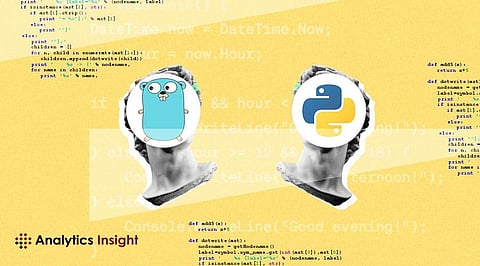

Programming languages are constantly evolving and changing, and choosing which one to learn can be a daunting task. There are many factors to consider, such as popularity, performance, features, libraries, and use cases. You can also go through some of the best YouTube channels to learn Python In this article, we will compare two of the most widely used and versatile languages: Golang and Python. We will examine their strengths and weaknesses, and help you decide which one is more suitable for your learning goals in 2024.
Golang, also known as Go, is a relatively new language, created by Google in 2009. It is a compiled, statically typed, and concurrent language, designed for building fast, scalable, and reliable systems. Golang is influenced by languages such as C, Pascal, and Python, and aims to provide simplicity, productivity, and performance.
A simple and clean syntax, with no semicolons, brackets, or classes.
A powerful and expressive type system, with support for interfaces, structs, and generics.
A built-in concurrency model, with lightweight threads called goroutines, and channels for communication and synchronization.
A rich set of standard libraries, covering a wide range of domains, such as networking, cryptography, compression, and testing.
A fast and efficient compiler, with cross-platform support and easy deployment.
A comprehensive and interactive documentation, with a built-in tour and playground.
Web development, with frameworks such as Gin, Echo, and Revel.
Microservices and cloud computing, with platforms such as Kubernetes, Docker, and AWS.
Data processing and analytics, with tools such as Apache Beam, InfluxDB, and Prometheus.
System programming and command-line tools, with utilities such as Hugo, Terraform, and Cobra.
Python is an older, but still very popular language, created in 1991. It is an interpreted, dynamically typed, and multi-paradigm language, known for its readability, simplicity, and versatility. Python is influenced by languages such as ABC, Lisp, and Perl, and aims to provide a high-level and expressive way of programming.
A clear and elegant syntax, with indentation, colons, and keywords.
A flexible and dynamic type system, with support for multiple inheritance, metaclasses, and duck typing.
A large and diverse set of standard libraries, covering a wide range of domains, such as web development, data science, and GUI.
A vibrant and active community, with thousands of third-party libraries, frameworks, and tools.
An interactive and exploratory environment, with a built-in shell and notebook.
Data science and machine learning, with frameworks such as TensorFlow, PyTorch, and Scikit-learn.
Web development, with frameworks such as Django, Flask, and Pyramid.
Scientific computing and numerical analysis, with libraries such as NumPy, SciPy, and Matplotlib.
Scripting and automation, with modules such as os, sys, and subprocess.
GUI development, with libraries such as Tkinter, PyQt, and Kivy.
Both Golang and Python have their advantages and disadvantages, depending on the context and the problem. Here are some of the main aspects to consider when comparing Golang vs Python:
Performance: Golang is generally faster and more efficient than Python, as it is a compiled and statically typed language, with native concurrency support. Python is slower and more memory-intensive, as it is an interpreted and dynamically typed language, with a global interpreter lock (GIL) that limits concurrency.
Ease of learning: Python is generally easier to learn than Golang, as it has a simpler and more readable syntax and a more intuitive and forgiving error-handling mechanism. Golang has a steeper learning curve, as it has a more strict and verbose syntax and a more explicit and manual error-handling mechanism.
Libraries and frameworks: Python has a larger and more diverse set of libraries and frameworks than Golang, as it has been around for longer, and has a more established and active community. Golang has a smaller and more focused set of libraries and frameworks, as it is a newer and more niche language, and has a more conservative and standardized approach.
Use cases: Golang is more suitable for use cases that require high performance, scalability, and reliability, such as system programming, microservices, and cloud computing. Python is more suitable for use cases that require rapid development, flexibility, and creativity, such as data science, machine learning, and web development.
There is no definitive answer to which language is better, as both Golang and Python have their pros and cons, and the best choice depends on the situation and the preference of the learner. However, some general guidelines are:
If you are a beginner, or you want to learn a language that is easy, readable, and versatile, then Python is a good option.
If you are an experienced programmer, or you want to learn a language that is fast, efficient, and concurrent, then Golang is a good option.
If you are interested in data science, machine learning, or web development, then Python is a good option, as it has more libraries and frameworks that support these domains.
If you are interested in system programming, microservices, or cloud computing, then Golang is a good option, as it has more features and tools that support these domains.
Ultimately, the best way to decide which language to learn is to try them both, and see which one suits you better.
Join our WhatsApp Channel to get the latest news, exclusives and videos on WhatsApp
_____________
Disclaimer: Analytics Insight does not provide financial advice or guidance. Also note that the cryptocurrencies mentioned/listed on the website could potentially be scams, i.e. designed to induce you to invest financial resources that may be lost forever and not be recoverable once investments are made. You are responsible for conducting your own research (DYOR) before making any investments. Read more here.
